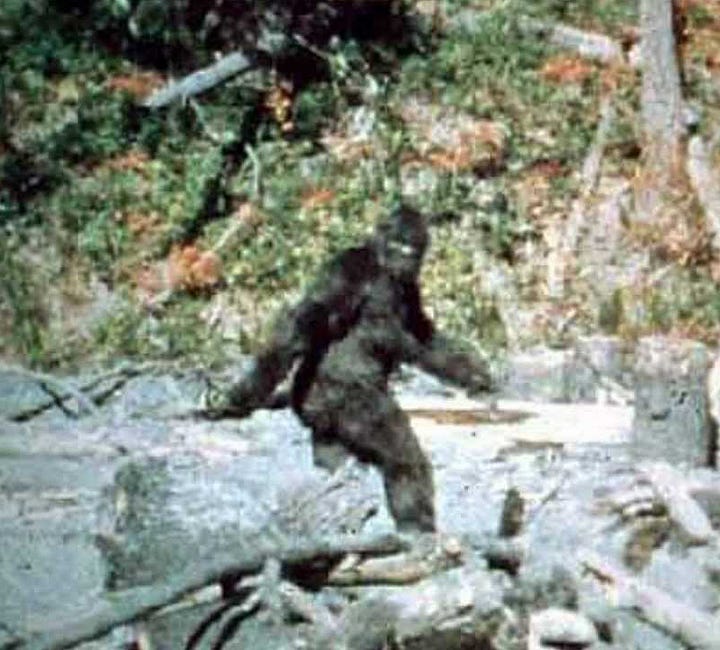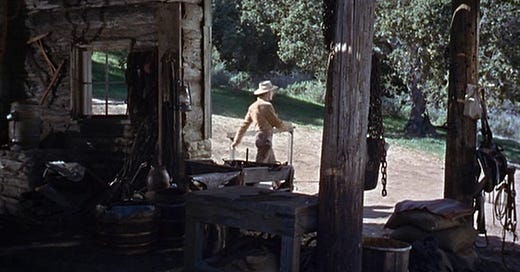In the 1954 film Riding Shotgun, Larry Delong (played by Randolph Scott) assumes the role of both hunter and hunted. Sometimes he knows this; sometimes he might not know it yet. For the film’s characters just as much as viewers, knowledge of who’s pursuing whom, who’s responsible for which acts, who’s intending to do what is kaleidoscopic, constantly opening up and unfurling into new patterns. The scenario is not especially novel or intricate, but the energy is notable, and of a quality I tend to ascribe to the director, Andre De Toth, one of the great (if still sometimes overlooked) émigré directors who decamped for Hollywood from Europe in the wake of fascism. The film’s opening seven minutes, furthermore, present a kind of self-contained, circular play that makes for a graceful and subtle prologue for the remainder of the movie.






Credits appear over the opening shot of the film. As the director’s credit fades, a stagecoach pulls up around a bend in the trail. Randolph Scott’s voiceover narration introduces him as he passes by, riding shotgun like the title says. “I knew that sooner or later my path would again cross that of the man I wanted.” The predominant camera movement of the shot is a pan left, and as we see the stagecoach exit the frame over the horizon, a man on horseback—the villain Dan Marady—emerges from behind the rocky landscape within the frame, riding into the foreground to hand over a gun to one of his co-conspirators.
The stagecoach, meanwhile, stops and all seems well—leisurely. There’s a nice lady, a trusty partner, a gee-whiz kid. But the bearded man who received the gun at the end of the first shot is on Delong’s trail. We see him arrive at the same destination. Without being precious about it—everything is quick, economical—De Toth largely frames this pursuer through grids and windows.
Inside the store, the bearded henchman flashes a gun that Delong recognizes as the lucky weapon of his nemesis, Maraday. Where’d he get that piece? The henchman plays dumb by design and says he got it off some dying man. Delong, believing he’s inadvertently stumbled onto Maraday’s trail, resolves to follow the henchman, who takes off quickly from the store to saddle up again and get back along the trail. Even as Delong is preparing to be the active stalker, the avenger, he’s blocked in the frame in a way that cages him in, makes him look uncertain, wary. (Why would I suggest Delong is “caged” in such compositions when the henchman, moments before in similar sorts of framings, isn’t? Well, it’s because we can see that the henchman accurately knows his target, and we see what his target is doing, whereas the henchman’s next steps are swift bait to both Delong and viewer alike.)




And so Delong mounts his horse and begins his own pursuit. We’re treated to a long take that echoes and reverses a few of the features of the opening shot, which involved a pan left and ended with the villain riding into the foreground. In this “closing” shot of the film’s informal prologue, the hero has just left the foreground to push into a more extreme distance from the camera as he follows his man, thirty yards or so behind. The camera pans right this time, rather than left, and ends by centering individuals associated with the stagecoach and the outpost, who are watching it all happen: the last minute of this opening sequence subtly underscores their role as spectators (these onlookers don’t have much weight in the remainder of the film), and it’s also in this stretch that Randolph Scott’s voiceover recognizes that he might actually have been duped—which is, of course, precisely what’s just happened. “I began to suspect he was leading me into a trap, but, I didn’t care as long as he led me to Marady. That’s what hate does, it makes a man careless.”



Fred Camper writes, “De Toth’s great theme is betrayal—not single betrayals by individuals but networks of betrayal that implicate most of his characters. In de Toth’s moral universe, the majority are susceptible to compromise, and the minority who remain pure—such as the rabbi who exhorts his fellow Jews to fight the Germans in None Shall Escape (1944)—wind up dead or otherwise ruined, their lives altered forever by the treachery they’ve survived.” This is as apt a summary of what tends to happen in De Toth movies as is likely to be found. Reversals of fortune abound, heroes suffer social shame and rejection, and it’s typically down to the weakness of people (potentially any people) to cleave to the comforts of prejudicial conformity when doing otherwise might diminish their safety or their social standing. The plot points (or, for some people, “beats”) that serve as the skeleton of these betrayals are often, in Riding Shotgun or the director’s other films, relatively conventional; what distinguishes the movies is the force, even the ferocity, and the volume of these kinds of beats. In so many De Toth films, including his best Westerns, Day of the Outlaw (1959) and Last of the Comanches (1953), it’s possible to identify a certain instant when the narrative really feels enlivened, and there’s no turning back. (In Outlaw it’s the bottle rolling down the bar … in Comanches, I recall it’s an arrow from out of nowhere.)




Later on in the story, when almost all of the townspeople believe that Delong helped a criminal gang, one of the youths slings a rock at our hero, who takes it on the cheekbone and draws his pistol at the boy. And of course, what any bystanders see is a gunman threatening to shoot a child. Confirmation bias as social sickness; bad luck compounding or inciting fragile ecosystems; the world falling out beneath one’s feet for failing to compromise quickly enough: these are the “networks of betrayal” that animate so many of De Toth’s films, the great and the good and even the more ordinary.
Resolution comes out of the balancing of some of these energies and patterns, and (as we might predict) the boy who slings the stone at Delong later does something good to compensate for his petty act of violence. This is reinforced by certain formal qualities, like the pan left/right balancing of the opening and closing long tracking shots of the film’s opening seven minutes, those seven minutes that set the stage for the first real electrifying moment and from there allow the very simple core conflict between Delong and Maraday to inhabit a series of more complex and ephemeral manifestations …




